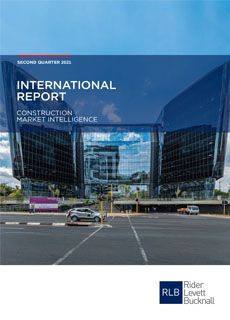According to the Rider Levett Bucknall (RLB) 2nd Quarter 2021 International Report, global border closures due to COVID-19 continue to adversely impact construction markets with most regions seeing upward pressure on construction pricing.
RLB Global Chairman, Mr. Kenneth Kwan said, “Global supply chains, disrupted during 2020, have not yet recovered to pre-Covid levels, with increased shipping costs and longer shipping times.”
“Disruptions caused by COVID-19 lockdowns, Brexit and other global issues have seen most regions struggle to source cross-border construction workers to cater to the growing appetite for construction activity globally and construction orders’ return to pre-COVID-19 levels,” he added.
Improved outlook due to increased vaccinations
Despite this, the world has seen an improved outlook since our last report for global economic growth which is supported by increasing numbers of vaccinations, particularly in advanced economies, and continuing containment measures. At the start of 2021, global COVID-19 cases numbered 84 million, and nearing the end of May they stood at 169 million.
According to RLB, the world’s three largest economies (the United States, China, and Europe) are experiencing differing outcomes. The United States is seeing strong stimulus-fuelled demand combined with supply chain disruptions, fuelling inflation. Europe is seeing increased demand together with economic restrictions being relaxed causing a fast tracking of growth as well as inflation.
China’s GDP grew 7.9% (YoY) in 2nd Quarter 2021. Compared with the surge of 18.3% (YoY) in 1st Quarter 2021, the rebound has been slowing but remained strong given the jump in Q1 was on a low base effect. Even though some trading partners slowly moved back to normal and required less demand from China, its drop was offset by a dual circulation strategy introduced by China’s 25-member policymaking committee in mid-2020. China decided to rely more on domestic consumer spending, shifting its growth engine from state-led investment and exports.
Global recovery uneven and varied
Mr Kwan continued, “Despite significant improvements to the overall outlook, the global economic recovery is likely to be uneven. In general, in coming years, advanced economies are expected to return closer to their pre-pandemic trajectories for GDP than emerging market economies. This reflects the broad trend of earlier vaccine access.”
“By comparison, the outlook for emerging market economies is more varied. Slower vaccine rollouts will weigh on recoveries, particularly in regions that are experiencing high virus caseloads, or are more reliant on contact intensive industries and international travel,” he noted.
Increase in construction cost inflation due to demand in residential housing
In our current global data capture, the majority of RLB offices across the globe have generally reported that much of the increase in construction cost inflation over the past six months has been due to a surge in the prices of commodities and inputs related to the surge in demand, especially in residential housing, together with supply chain disruption.
The shortfall in skilled workers within the construction sector in most regions was the second most commented-upon construction cost impact. Labour shortages, particularly among skilled labourers, have led to delays and increased costs in construction work across all regions. Border lockdowns continue to constrain the availability of international workers, so causing shortages of skilled labourers in the industry globally.
Labour shortages continue in both US and UK
Border restrictions have also limited many regions’ reliance on untrained immigrant labour in meeting current construction demand. Singapore, Malaysia, Qatar and UAE, who have traditionally relied on this form of labour, continue to struggle to fill demand.
Within the US, leading economists believe people still fear both contracting and spreading the virus, while others prefer to receive unemployment benefits rather than what they would earn in available jobs.
Within the UK, the double dose of Brexit and COVID-19 impacts has fuelled a shortage of construction workers and materials. The UK lost a quarter of its European-born construction workforce between January 2020 and January 2021, according to the Construction Products Association.
The extension of the Furlough scheme has also been reducing people’s motivation to fill vacancies. Post-Brexit immigration rules and immigration could limit the return to the UK of thousands of overseas workers who returned home during lockdowns, exacerbating the problem of limited available labour.
Government responses indicate a preference towards the engagement of training and apprenticeship program schemes to mitigate this issue, but of course upskilling and training takes time. Key material shortages include steel, timber and cladding.
Germany takes different approach
This action by the UK contrasts with that of Germany, where they are implementing the Skilled Immigration Act that will allow a streamlining process for mitigating skilled shortages in growth areas such as engineering. The return of European workers to their home countries is also providing opportunities for returning labour. Other EU countries are responding to training and education to supply the industry. This is seen in Ireland where there are reports of shortages in all trades and the government has committed to increased opportunities for more training and education instead of depending on overseas workers.
Within Australia, Master Builders Australia reported that 78% of domestic home builders are reporting “significant delays in being able to secure concreters, joiners and bricklayers” and “an increase in up to 10% in the cost of materials and specialist trades or labour”.
Skilled labour shortages and pressure on construction costs to continue
Mr Kwan concludes, “Looking at the final region covered by RLB’s International Report, New Zealand has also implemented hard borders and the government is signalling a move away from “low skill” migrant labour to fill necessary construction vacancies. However, with competition for skilled workers still strong, the lead time for upskilling domestic workers will take time.”
“Generally, discussion has centred on border lockdowns causing the reduction of international workers that has caused shortages of skilled labourers in the industry globally. Additionally, government incentives, especially promoting new domestic housing, has increased demand for skilled workers. Labour shortages coupled with global supply chain disruptions are adding pressure on construction costs around the globe.”



